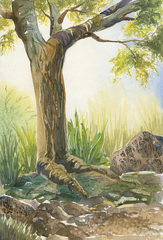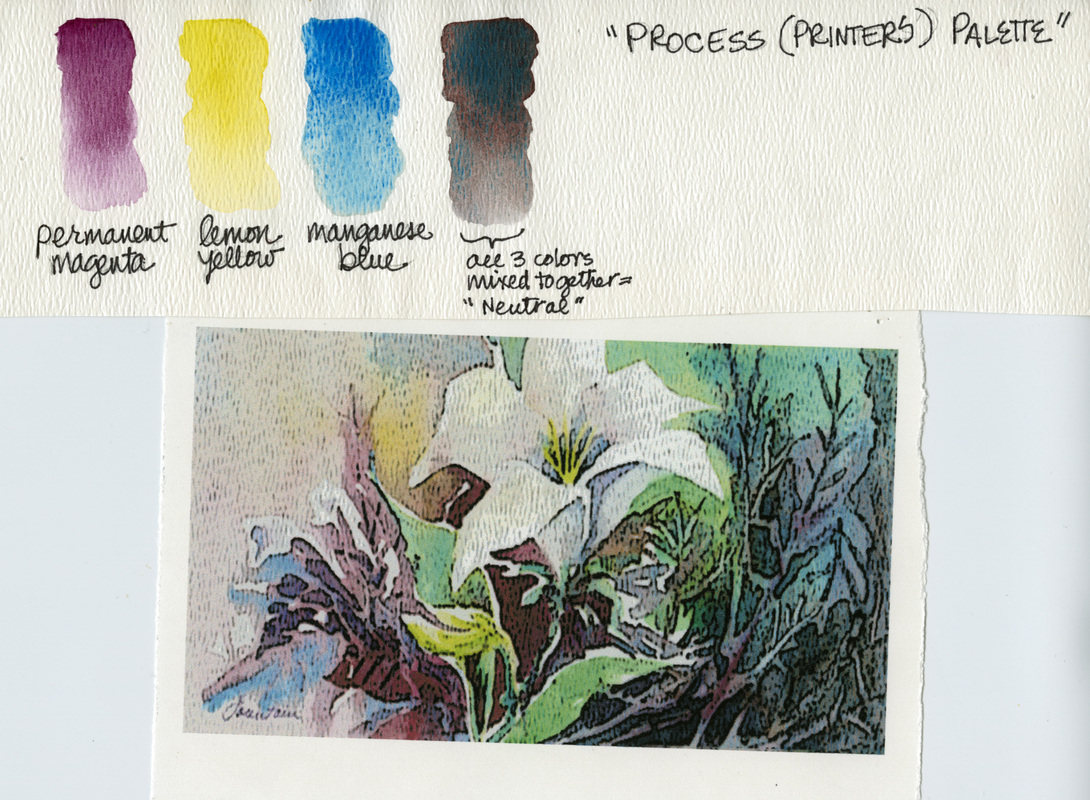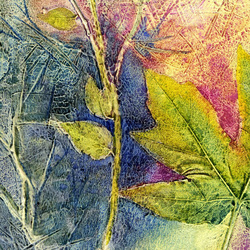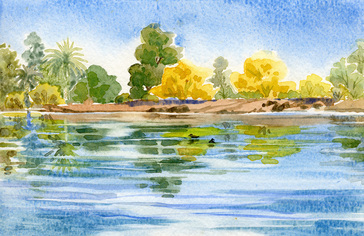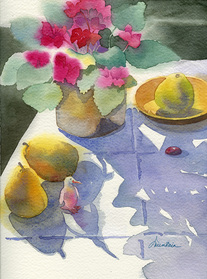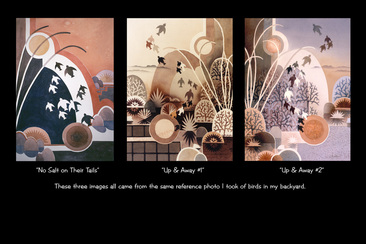All the lessons listed here are in PDF format. Simply click the lesson you want and download it.
Some of the lessons have accompanying slides - click on the slides to download them. Slides are intended as inspiration for the most part, and illustrate how various artists use the concepts in their work. You may want to do further research on these artists.
Please note: These materials are copyrighted by Ellen A. Fountain. They are NOT to be offered for sale.
|
Introduction to Watercolor Painting
Paint, paper, water and a brush - that's all you need to start painting with watercolor. Here are brief introductions to these basics. Introduction to Watercolor - BRUSHWORK Introduction to Watercolor - WASHES Introduction to Watercolor - PIGMENT CHARACTERISTICS/PROPERTIES Introduction to Watercolor - Textural Effects and Whites |
Color Mixing and Theory for Watercolor Painters
Some of these have exercises to do, some are informational only. The 3-color palette worksheets are just that - a testing sheet for various primary color combinations. You can have this copied on lightweight (80-90 lb) watercolor paper.
Some of these have exercises to do, some are informational only. The 3-color palette worksheets are just that - a testing sheet for various primary color combinations. You can have this copied on lightweight (80-90 lb) watercolor paper.
Color and Value - Exploring Hue, Value, Temperature and Intensity - 6 Weeks
Syllabus
Week 1 - High Key Values
Week 2 - Low Key Values
Week 3 - Full Value Range
Week 4 - Color Temperature
Week 5 - Color Intensity
Week 6 - Hue: Local vs. Arbitrary
Extra: Avoiding Dirty Lights
Syllabus
Week 1 - High Key Values
Week 2 - Low Key Values
Week 3 - Full Value Range
Week 4 - Color Temperature
Week 5 - Color Intensity
Week 6 - Hue: Local vs. Arbitrary
Extra: Avoiding Dirty Lights
Mixed Water Media Painting - 4 weeks
Watercolor Mixed Media Painting 4-week Syllabus
Week 1 - Watercolor with Opaque Acrylic or Gouache
Week 2 - Watercolor with Ink
Week 3 - Watercolor with Gesso *
Week 4 - Watercolor with Collage Elements
* If you want a more in-depth tutorial on this subject, consider ordering my workbook on this subject.
Download these for additional ideas and processes:
How to Make Acrylic Sheets for Mixed Media works
Acrylic Transfer Directions
Watercolor Mixed Media Painting 4-week Syllabus
Week 1 - Watercolor with Opaque Acrylic or Gouache
Week 2 - Watercolor with Ink
Week 3 - Watercolor with Gesso *
Week 4 - Watercolor with Collage Elements
* If you want a more in-depth tutorial on this subject, consider ordering my workbook on this subject.
Download these for additional ideas and processes:
How to Make Acrylic Sheets for Mixed Media works
Acrylic Transfer Directions
|
Watercolor on Gessoed Paper
Learn more about and explore an alternative painting surface - gesso - with this lesson. Beautiful textural effects are possible, and you can wipe back to the white gessoed surface several times before it stains permanently. Watercolor on Gessoed Paper Artists Working on Gessoed Paper Paint Pigments for Gessoed Paper Download the slides |
|
Painting Water in Watercolor
Painting Moving Water Painting Still Water Images for Handouts Illustrations Moving Water Images Still Water Images |
Still Life - Literary Inspiration - 6 Weeks
This class uses figures of speech and other literary devices as inspiration for content, and couples that each week with specific watercolor painting techniques commonly used in still life paintings. The slides for the above class (Considerations for Still Life) are also appropriate for this class.
Syllabus
Week 1 - Content: Metaphor - Technique/Underpainting Shadow Areas in Fabric
Week 2 - Content: Irony - Technique/Masking for a Batik Look
Week 3 - Content: Parody - Technique: Stencils or Stamps for Pattern Making in Fabric
Week 4 - Content: Synecdoche - Technique: Painting Reflective Surfaces
Week 5 - Content: Personal Symbolism - Technique: Glazing for Richer Color
Week 6 - Content: Narrative - Technique: Any Used this Class
Slides: Considerations for Still Life Painting
This class uses figures of speech and other literary devices as inspiration for content, and couples that each week with specific watercolor painting techniques commonly used in still life paintings. The slides for the above class (Considerations for Still Life) are also appropriate for this class.
Syllabus
Week 1 - Content: Metaphor - Technique/Underpainting Shadow Areas in Fabric
Week 2 - Content: Irony - Technique/Masking for a Batik Look
Week 3 - Content: Parody - Technique: Stencils or Stamps for Pattern Making in Fabric
Week 4 - Content: Synecdoche - Technique: Painting Reflective Surfaces
Week 5 - Content: Personal Symbolism - Technique: Glazing for Richer Color
Week 6 - Content: Narrative - Technique: Any Used this Class
Slides: Considerations for Still Life Painting
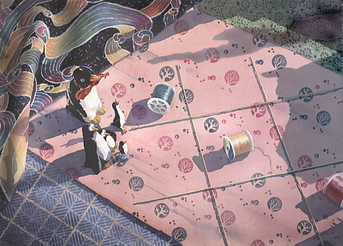 Childsplay - 30" x 40", collection Tucson Medical Center, Watercolor by Ellen A. Fountain Childsplay - 30" x 40", collection Tucson Medical Center, Watercolor by Ellen A. Fountain
Slides for Food Theme
Slides for Windows/Doors Slides for Basic Elements Slides for Night Slides for Play Slides for Enclosures Slides for Time Slides for Appropriations Slides for Love Slides for Flight Slides for Legs/Feet |
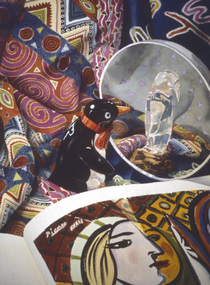 Beginning to See What He Saw,
Watercolor by Ellen A. Fountain - private collection Beginning to See What He Saw,
Watercolor by Ellen A. Fountain - private collection
|
Painting Reflective Surfaces:
Metal, Glass and Mirrors Practice looking carefully and translating reflective surfaces into paint on paper. Week 1 - Metals Week 2 - Glass Week 3 - Mirrors Slides of Artists Works Reference Photos to Use for Exercises |
Renewing/Re-Inventing Your Watercolor Work
Exercises to help you jump start yourself out of a slump, or push yourself in a new direction
Exercises to help you jump start yourself out of a slump, or push yourself in a new direction
|
Painting a Series
How to expand your composition, thinking and painting skills by re-painting themes or subjects in new ways. - Generating Ideas for Series - Working with Subject Matter - Notes on Themes and Series by Various Artists - Slides for Painting a Series |
